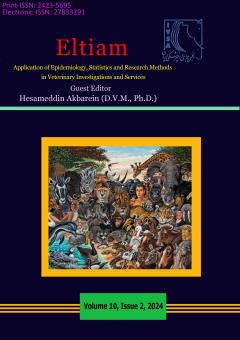An overview of sampling, sample size and data collection methods in veterinary research
Subject Areas : Other Related Sciences
Dariush Saadati
1
*
![]() ,
Samira Saadat jou
2
,
Ali Anusha
3
,
Samira Saadat jou
2
,
Ali Anusha
3
1 - Department of food hygiene, Faculty of Veterinary Medicine, University of Zabol, Zabol, Iran
2 - DVM Graduated from Faculty of Veterinary Medicine, university of Tehran, Veterinary clinician in Zabol, Zabol, Iran.
3 - Ph.D. student in Animal genetics and breeding, Faculty of Agriculture, University of Zabol, Zabol, Iran
Keywords: Sample size, Statistical sampling methods, Data collection methods,
Abstract :
At the beginning of any study, these questions usually come to the researcher's mind; How many samples should be taken to conduct this study? How are these samples selected from the target population? How I can collect the required data? In this article, we are going to answer these questions. In order to choose the appropriate sample size, attention should be paid to the statistical method with which the data is to be analyzed. In the surveys, the researcher intends to estimate the desired average or prevalence in the population with 95% confidence interval. There are two formulas for determining the sample size in surveys that are referred to. In studies, the aim is to compare the average or prevalence between different groups. In each study, according to which statistical test to use for data analysis, there is a specific formula for determining the sample size, some of which are mentioned in this article. In order to choose the sampling method from a statistical point of view, attention should be paid to the type of research, in surveys and cross-sectional observational studies, the samples should be randomly selected from among the members of the population. Otherwise, these samples will not be representative of the target population. But in interventional studies, random sampling method is not considered. Rather, there are inclusion criteria, and any person or animal (in veterinary studies) who meets these criteria can enter the study. After the members enter the intervention study, these members should be randomly assigned to different treatments. The required data to conduct research can be collected through examination, observation, experiments or interviews. A questionnaire must be designed for the interview. In designing the questionnaire, attention should be paid to the validity and reliability of the questions.
1. Cochran WG. Sampling techniques: : 3th edition. John Wiley & Sons; New york, 1977. #
2. Narouei M-R, Saadati D, Najimi M, Gangali H, Shah Karami F. Prevalence and risk factors of Brucella infection in sheep and goats in the Sistan region by PCR method. Journal of Zoonotic Diseases. 2022. https://doi.org/10.22034/jzd.2022.15111. #
3. Mohammad K, Malekafzali H. Statistical Methods and Health Indices. 19th edition. Jafari Novin; Tehran, 2021. 360 p. #
4. Michael T, Robert C, Helen B, Peter J, Diggle, Nigel F, Keith H, Louise K, Annette O, Jan S, Hannah W. Veterinary Epidemiology: 4th edition. John Wiley & Sons; 2018. https://doi.org/10.1002/9781118280249.#
5. Haghdoost A. Do You Want to Gain a Profound Insight into Sample Size and Statistical Power. Iranian Journal of Epidemiology, 2009;5(1):57-63.#
6. Charan J, Biswas T. How to calculate sample size for different study designs in medical research? Indian Journal of Psychological Medicine. 2013;35(2):121-6. https://doi.org/10.4103/0253-7176.116232.#
7. Chow S-C, Shao J, Wang H, Lokhnygina Y. Sample size calculations in clinical research: CRC press; 2017. https://doi.org/10.1201/9780203911341.#
8. Stevenson MA. Sample size estimation in veterinary epidemiologic research. Frontiers in Veterinary Science. 2021;7:539573. https://doi.org/10.3389/fvets.2020.539573.#
9. Anvari D, Saadati D, Nabavi R, Eskandani MA. Epidemiology and molecular prevalence of toxoplasma gondii in cattle slaughtered in Zahedan and Zabol Districts, South East of Iran. Iranian Journal of Parasitology. 2018;13(1):114. PMID: 29963093.#
10. Jahantigh M, Kalantari H, Ayda Davari S, Saadati D. Effects of dietary vinegar on performance, immune response and small intestine histomorphology in 1‐to 28‐day broiler chickens. Veterinary Medicine and Science. 2021;7(3):766-72. https://doi.org/10.1002/vms3.408.#
11. Sibbald B, Roberts C. Understanding controlled trials crossover trials. BMJ. 1998;316(7146):1719-20. https://doi.org/10.1136/bmj.316.7146.1719.#
12. Nanjundeswaraswamy T, Divakar S. Determination of sample size and sampling methods in applied research. Proceedings on Engineering Sciences. 2021;3(1):25-32. https://doi.org/10.24874/PES03.01.003.#
13. Sharma G. Pros and cons of different sampling techniques. International Journal of Applied Research. 2017;3(7):749-52.#
14. Nabavi R, Eslami A, Shokrani H, Bokaie S, Shayan P, Saadati D. Study on the prevalence, intensity and seasonal dynamics of abomasal helminths in sheep from different climatic zones of Iran. World Appl Sci J. 2011;12(4):441-5.#
15. Rashki-ghalehnoo Z, Saadati D, Tajrobe-kar O. comparison of intensive and non-intensive microbiology courses on the learning of pharmacy students. studies in Development of Medical Education. 2015;12(3):545-9.#

